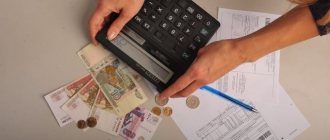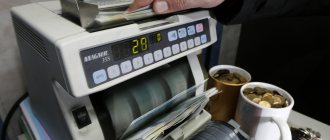Last update: 11/28/2020
How money is transferred for an apartment (the method of cash payments) depends on the type of market in which we buy or sell an apartment.
In the primary market, payments occur between an individual (Buyer) and a legal entity (Developer), and therefore are carried out non-cash . The Developer is in charge of the settlement procedure here. The transfer of money from the Buyer's account occurs on the basis of an invoice issued by the Developer, in accordance with the terms of the purchase agreement for a new building.
For Equity Participation Agreements (EPA), starting from 2021, the law provides for an alternative payment method that protects shareholders’ money - through escrow accounts (from July 1, 2021, their use has become mandatory for Developers). In this case, the money is also transferred by bank transfer, but not to the Developer, but to a special bank account - an escrow account (for more details, follow the link).
In the secondary market, payments occur between individuals, and there may be several of them (if the “deal is alternative”), and here they often pay for an apartment in cash , a little less often - by bank transfer (for example, if the apartment is purchased with a mortgage or with the help of subsidies).
Obviously, cash payments on the “primary” market are not difficult, while on the “secondary” market it is quite risky to hand over a suitcase of money to the Seller. Especially in an “alternative transaction” where the money is distributed among a number of participants. How is this issue resolved in practice?
Buying an apartment and renting it out – is it profitable? Calculations and answer in this post.
There are three safe ways to transfer money when buying or selling an apartment on the secondary housing market:
- Bank safe deposit box;
- Letter of Credit.
- Payments at the notary (through the notary's deposit) .
The first method is used for cash , the second and third methods are used for payments exclusively by bank transfer . Let's consider all three methods in order.
!!! Online order Extracts from the Unified State Register and other SERVICES for purchasing an apartment - HERE.
What to do if the Seller does not check out of the sold apartment - see this note.
Renting a safe deposit box
Rent of a safe deposit box is carried out on the basis of a client agreement with a financial institution. The credit institution sets a fee for using the depository safe. The cost of services depends on the tariffs established by the bank, the type of agreement (lease or safekeeping), and the size of the safe. An agreement with a credit institution is concluded for a certain period. Penalties are provided for late release of the storage facility or loss of the key. When concluding an agreement for the safekeeping of valuables, an inventory of the contents of the safe is drawn up.
Sample receipt
In order for a receipt for receipt of funds to have legal significance, it must be drawn up according to certain rules. They are as follows:
- Only the person who, in accordance with the DCP, is the recipient of the money, must write a receipt. No relatives, even the closest relatives, should appear in this document (with the exception of cases when the seller, due to a physical disability, illness or illiteracy, cannot sign with his own hand, then at his request another person can sign the transaction. The latter’s signature must be certified by a notary or other an official who has the right to perform such a notarial act, indicating the reasons why the person making the transaction could not sign it with his own hand (Article 160 of the Civil Code of the Russian Federation));
- The document must include the following details: name of the document (receipt), place, date and time of preparation;
- the receipt must contain a record that this amount was received specifically for the sold real estate, and not for any other goods or services;
- the document must indicate the exact address and cadastral number of the sold apartment;
- the text of the receipt must contain a reference to the purchase and sale agreement under which the obligations of the parties to the transaction are fulfilled (it may, for example, include the following phrase: “The money was received in full, in accordance with such and such a clause of the agreement on such and such a date”);
- the receipt must indicate the full surnames, first names and patronymics of the parties to the transaction and their passport details, including residence and registration addresses;
- the receipt indicates the exact amount of funds received (in numbers and in words);
- The document is certified by the Buyer’s signature with a full transcript of the full name written by hand.
If these rules are not followed, in the event of a dispute regarding the transaction, the court may recognize the document as having no legal force and not accept it for consideration. To further enhance the legal significance of the receipt, it is often written in front of witnesses who also certify the document with their signatures.
Receipts for receiving money are usually written by hand, but the option of typewritten writing is not excluded, where a signature is put by hand and only a transcript of the Seller’s name is written. The receipt is drawn up in one copy, which is transferred to the Buyer after all conditions for the transaction have been fulfilled and mutual settlements have been made between its parties.
If payments for an apartment are made non-cash, for example through a letter of credit, then the document confirming the payment is a bank payment order indicating the transfer of funds to the Seller.
Sometimes it happens that the method of mutual settlements is not clearly indicated in the policy. In this case, with non-cash forms of payment, Buyers may require from Sellers a document that confirms the fact of transfer of money to the Seller’s bank account. In this case, the Seller should make a note that the funds in such and such an amount on such and such a date were received in full by means of a non-cash bank transfer (receipt of funds into a bank account). A receipt for receiving money for an apartment does not require mandatory notarization.
Money in a safe deposit box
The client can store money in a safe deposit box - any amount and in any currency. For using the safe deposit box, he will have to pay rent to the bank. Unlike placing funds in deposit accounts, when storing money in a safe, the client does not accrue interest on the amount. The client can withdraw all or part of the money from the vault at any time, or increase the amount - there are no sanctions for this. The bank is responsible only for the security of the safe deposit box and vault, but not for the contents of the safe. To minimize risks, you can create an inventory of the contents of the cell.
Is there a guarantee of safety of valuables in the cell?
This is influenced by the agreement that the client has signed with the financial institution.
Rental agreement with the provision of a cell
This option gives you a place to store your valuables. Bank employees are not aware of what is in the safe, so they are not responsible for it. However, they are committed to refusing to allow others to open the safe without your consent.
If money or precious metals disappear, the financial institution will not be obligated to reimburse them. Therefore, it will be difficult to convince the company about the contents of the value cell.
Rental agreement using a storage facility
The buyer informs the financial institution what exactly will be stored in the safe. In turn, the bank assures the tenant that it will not allow other persons to access the locker without the buyer’s consent.
In the event of a robbery, the financial institution is also not responsible for the contents of the cell. However, there is a chance to get your money back.
In case of theft, the client must file a claim with the financial institution and register the crime with the police. The lack of response from the credit institution allows you to file a lawsuit. The document must contain information about the need to return cash and compensate for moral damage.
The owner must prove that cash was stolen during the theft. To do this, you must have witnesses or video recording.
Renting a safe deposit box per month costs about three thousand rubles.
Agreement for the use of a safe deposit box with a safekeeping service
You will have to pay more for such an agreement than for renting with use or provision. The financial organization records what is in the safe, verifies the authenticity of the money, its quantity, and draws up an inventory.
It is possible to open and remove property from a safe deposit box only in the presence of a bank employee, since now the credit institution has responsibility for the components of the storage facility. If property is lost, the organization is obliged to pay for the damage.
To protect the contents of your safe, you can insure it. Banks usually provide this service.
Payment via safe deposit box
When making payments through a safe deposit box, the seller and buyer jointly enter into an agreement with the financial institution. An additional agreement is concluded with the contract, stipulating the conditions for access to the safe of one of the tenants. The buyer, in the presence of the seller and a bank representative, places money in the safe. After registering the purchase and sale transaction, the seller, upon presentation of the key, identification card and documents on the sale of real estate to the bank representative, can withdraw the money.
Such operations are carried out during transactions of purchase and sale of real estate, cars and other valuables.
Why is a receipt needed?
The seller’s receipt of money from the buyer is needed in a variety of situations that may arise in the process of buying and selling an apartment.
For example, if the agreement contains an entry that funds are transferred under certain specific conditions (through a letter of credit or a safe deposit box), then this agreement itself represents a kind of written obligation of the parties to the transaction to perform certain actions, and nothing more. Only those that are confirmed by documents such as a deed of transfer (acceptance and transfer act) of real estate and receipts for receipt of funds (or a bank payment document) can be considered fully fulfilled obligations of the parties to a transaction. In the deed of transfer (deed of acceptance and transfer) of the apartment, as a rule, an entry is also made that the parties to the transaction have no mutual claims and that the settlements between them have been completed in full. A receipt for receipt of money in this case becomes a kind of additional insurance for the Buyer that he has paid for the purchase of the apartment and fulfilled his obligations.
In addition, this document always remains in the hands of the buyer and can be used, for example, in the event of any disputes regarding the transaction. Moreover, the presence of such a document is directly mentioned in the current legislation. The receipt is mentioned in Art. 408 of the Civil Code of the Russian Federation “Termination of an obligation by performance.”
Safe deposit box services
Russian banks provide clients with safe deposit box services. Depositories of financial institutions are located in various cities and regions, which provides convenient territorial access. Credit institutions have safes of various sizes, allowing you to store both a small number of documents and works of art and other large-sized valuables. Rental period - from 1 day or more. Safe deposit box services can be provided in a package with opening a deposit and issuing a bank card.
Advice from Sravni.ru:
When planning to rent a safe deposit box, you should familiarize yourself with the tariffs of various banks and the conditions of storage in the depository.
Features of drawing up a receipt for the sale of apartments with several owners
In the case of purchasing an apartment from several owners (an apartment in common ownership), the registration of a receipt has some features.
If an apartment is purchased from two or more co-owners, then the receipt must be signed by everyone who signed the purchase and sale agreement. In the case when the apartment was in common shared ownership, and the sellers received money based on the size of each share in the real estate, then each of the co-owners (the seller of the share) draws up a separate receipt, which indicates the amount that is due only to him.
Payments for an apartment through a safe deposit box
The most common way to transfer money for an apartment in purchase and sale transactions on the secondary market is to pay in cash using a safe deposit box . The payment terms here are specially adapted for real estate transactions, including multi-stage “alternative” transactions (when several apartments are purchased and sold at the same time).
A bank safe deposit box is a small safe (see photo) the size of a desk drawer in a special bank storage bunker (depository), which the bank rents out for any period of time for storing money and other valuables. Moreover (important!), the bank does not control what exactly the tenant will store in the safe deposit box. The bank provides only security for the safe itself and control of access to it (Article 922 of the Civil Code of the Russian Federation - Storing valuables in an individual bank safe). Thus, complete confidentiality of payments through the cell when purchasing an apartment is ensured.
The tenant of the cell is usually the Buyer of the apartment, and he also puts money there for the Seller. The Seller can withdraw this money strictly in accordance with the terms of agreement (additional agreement to the locker rental agreement), which is concluded between the Buyer, Seller and the bank (see sample agreement and additional agreement below).
This additional agreement specifies the conditions for access to the money box for the Seller of the apartment - i.e. specific deadlines when he can do this, and documents that he must present to the bank. The bottom line is that the Seller must document to the bank the fact of selling the apartment to the Buyer , then the Seller will have the opportunity to withdraw money from the safe deposit box (i.e., will gain access to it). If, after the expiration of the specified period , he has not done this, then the Buyer can take his money back. At the same time, during the same specified period, the Buyer himself does not have access to the cell.
Buying an apartment in a civil marriage - what is the best way to arrange it?
Usually, the pass for access to the box for the Seller is his passport and the Apartment Purchase and Sale Agreement (his copy, original), with the stamp of Rosreestr, the seal and signature of the registrar, and a record that the transaction has passed state registration and the apartment has become the property of the Buyer.
♦ An example of a seal with the signature of the registrar and the Rosreestr stamp on the contract ♦ (Click! And the example will open in a pop-up window.)
Note! If the registration of the transaction was electronic (including when the notary transmits the documents certified by him to Rosreestr via electronic communication channels), then the contract is also returned in electronic form . There will no longer be a Rosreestr stamp, seal or signature of the registrar on the agreement. This circumstance must be taken into account when drawing up the conditions for access to a cell with money.
If the electronic registration was carried out by a notary, then he himself then files an additional sheet with the number and date of registration to the agreement and certifies them with his signature and seal. The bank should be aware of this so as not to block the Seller’s access to the cell.
An additional condition for access to a safe deposit box may be (by agreement of the parties), in addition to the apartment sale agreement, an Extract from the Seller’s House Register, or a replacement Unified Housing Document, which confirms the deregistration of all residents of the sold apartment. Some also include in the terms of access an Extract from the Unified State Register, where the Buyer already appears as the owner.
The convenience and safety of payments in real estate transactions here lie in the fact that cash is counted, checked (counters and banknote detectors are provided by the bank) and deposited by the Buyer in a safe deposit box in the presence of the Seller. Then the money is blocked there for the duration of the transaction registration, and is transferred to the Seller only if the apartment purchase and sale transaction is registered . If for some reason registration did not occur and the transaction did not take place, then the Buyer again gains access to the cell and takes his money back (see example below).
What do realtors actually do? Frankly about the hidden - in this note.
The lease agreement for a safe deposit box for an apartment transaction can also be tripartite – Buyer, Seller and bank. Moreover, the Buyer and the Seller are both tenants of the cell, which does not change the essence of the agreement. The principle of accessing the cell remains the same.
The key to the safe deposit box usually remains with the Buyer of the apartment during the registration of the purchase and sale transaction, and then is transferred to the Seller in exchange for a receipt for receiving money for the apartment. But by agreement of the parties, after placing money in the safe deposit box, the key to it can be immediately transferred to the Seller (after all, without registration documents, he will still not have access to the safe deposit box). Or - left for safekeeping in the bank itself.
How this is decided in practice - who keeps the key to the safe deposit box - can be read on our thematic FORUM at the link.
In addition, the additional agreement to the lease agreement for a safe deposit box may provide for the possibility of joint access the conditions for access of the Seller and the Buyer separately specified therein
This option is useful if, during the preparation of the transaction, force majeure arose, for example, and the parties abandoned the transaction. Then the Buyer has the opportunity to withdraw his money from the cell without waiting for the period of his access specified in the contract. Another case for shared access is if, as a result of unforeseen circumstances, it was necessary to extend the term of the additional agreement or change the conditions of access to the cell.
♦ An example of transferring money for an apartment through a safe deposit box ♦ (Click! And a scheme for transferring money through a safe deposit box will appear in a pop-up window)
In practice, this is the most common, inexpensive and safe method of cash payments in real estate transactions . In those banks where there is a depository (depository), employees will always help with the correct execution of the locker rental agreement and additional agreement to it.
Rent of safe deposit boxes for transactions (Sberbank, VTB, Alfa Bank) - HERE (SERVICES).
The cost of renting a safe deposit box is “kopecks” (on the scale of the transaction), and varies between 2-3 thousand rubles/month. An additional agreement is somewhat more expensive (3-5 thousand rubles).
Additionally, the bank may charge an insurance premium for the safe deposit box and a deposit for the key to the safe deposit box (in case it is lost).
A sample Lease Agreement for a safe deposit box and an additional agreement to it can be downloaded HERE (SERVICES).
Settlements through a safe deposit box in alternative transactions
In alternative transactions and in chains of apartments, cash payments have their own characteristics. In particular, they rent not one, but two or several safe deposit boxes, and access to them is provided through separate additional agreements for each recipient of the money.
how to link together the interests of several participants in an alternative transaction when transferring money:
How money is transferred in alternative transactions for the purchase and sale of apartments (algorithm of actions) - see the link provided.
can organize the process of transferring money in a real estate transaction and link it with the registration process yourself. Or you can entrust this procedure to third-party providers , who will help you correctly draw up the conditions for access to bank safe deposit boxes, and will themselves register the entire package of documents. This service may be especially relevant in cases of complex alternative transactions and chains of apartments.
A third-party contractor can be either a representative of a specialized office (registration services) or a realtor from a real estate agency (if it is present when organizing the transaction). Or - a notary, if the Apartment Sale and Purchase Agreement (APA) was drawn up and certified by him (see below “Settlements through a notary”).
Conditions of the Agreement for the sale and purchase of an apartment on the secondary market. What is important here for the Buyer?
Another tip for the Buyer - check the size of the bank cells . In depositories, there are usually several types (sizes) of cells, including very small ones, which may not fit the entire amount of cash, for example, for the purchase of a three-room apartment in Moscow.
VIDEO: Nuances of paying for an apartment through a safe deposit box - What may be the risk of the Buyer of an apartment when transferring cash through a safe deposit box? Lawyer's recommendations.









